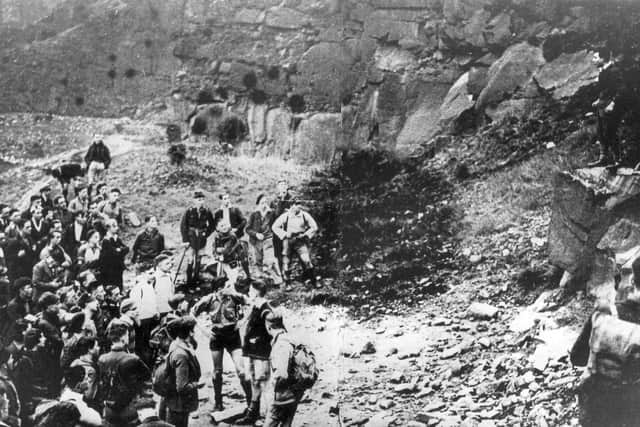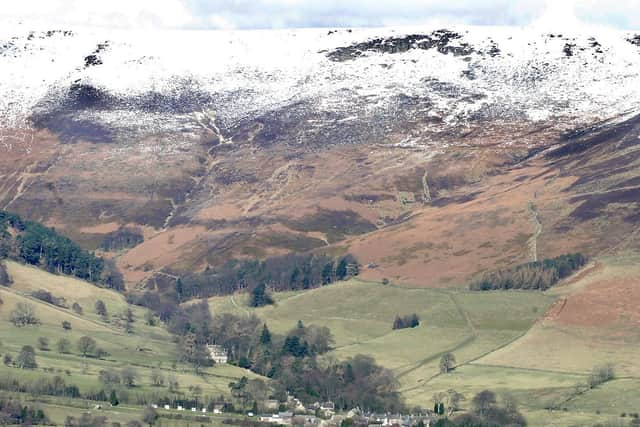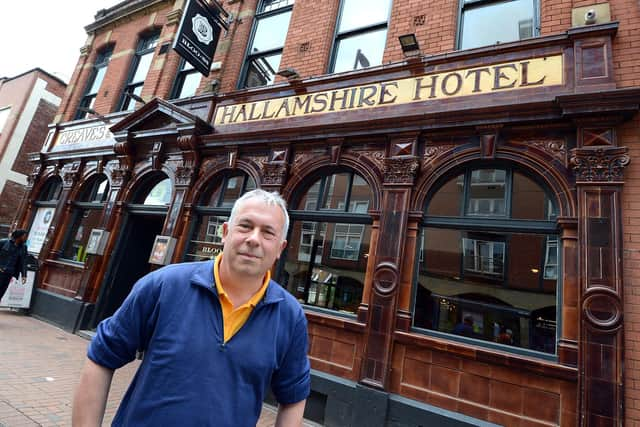Kinder Mass Trespass 90th anniversary: Sheffield walkers join new battle over public access
and live on Freeview channel 276
As Kate Ashbrook, general secretary of the Open Spaces Society, puts it: “Ninety years ago this April, the trespassers on Kinder Scout in the Peak District made a brave bid for freedom.
“In the footsteps of the Kinder trespassers we must mount a renewed campaign for better, funded access throughout England and Wales. The protected landscapes and national trails
must lead the way.


Advertisement
Hide AdAdvertisement
Hide Ad“It is sad that the Government has not marked this event, the anniversary of the Kinder Scout trespasses, with a strong statement on access in its long-awaited response to the Glover
review on protected landscapes.”
One of the most successful acts of civil disobedience in British history


On April 24, 1932, one of the most successful acts of civil disobedience in British history took place when a mass trespass occurred at Kinder Scout in what is now the Peak District National Park in Derbyshire, England, seeking to highlight that walkers in England and Wales were denied access to areas of open country.
The trespass arguably led to the passage of the National Parks legislation in 1949 and helped pave the way for the establishment of the Pennine Way and other long-distance footpaths.
It was a coordinated protest involving three groups of walkers who approached Kinder Scout from different directions at the same time.


Advertisement
Hide AdAdvertisement
Hide AdDuring the early 1930s, there were a number of protesters seeking greater access to the moorlands of the northern Peak District. However, what set the Kinder Scout protest apart was that it was a more radical approach to the issue - which was not universally popular with rambling groups at the time.
Every year in April, a combination of wardens and rangers from The National Trust and the Peak District National Park Authority hold a walking event to mark the anniversary of the
trespass.
The Royal Town Planning Institute North West, guided by Hayfield Kinder Trespass Group, also holds a guided walking tour where visitors learn about the history and context around the protest.
This year it is taking place on April 24, 2022, from 10.30am-4pm.
Advertisement
Hide AdAdvertisement
Hide AdA commemorative plaque now also marks the start of the trespass at Bowden Bridge quarry near Hayfield, which is today a popular area for ramblers. It was unveiled in April 1982 by Benny
Rothman, who was then aged 70, who was one of the original organisers of the protest, during a rally to mark the 50th anniversary.
Marking the Kinder Mass Trespass anniversary
The Open Spaces Society believes that the Government should be taking advantage of the upcoming anniversary of the Kinder Scout protest, with Ms Ashbrook making a comparison
to the Welsh government, which is marking the tenth anniversary of the Wales Coast Path in May, with a review being led by the Senedd member for Ogrore, Huw Irranca-Davies.
Advertisement
Hide AdAdvertisement
Hide AdThat review will determine practical actions, and will enable the Welsh government to maximise the route’s potential to generate all-round benefits for the next ten years.
“The words from the Department for Environment, Food and Rural Affairs (DEFRA) are hesitant and woolly,” says Ms Ashbrook.
“The Glover review called for the expansion of open-access rights in national parks and areas of outstanding natural beauty, but Defra offers nothing new.”
The Government announced it agrees that National Parks and Areas of Natural Beauty should be better for wildlife and people, but National Parks and AONBs are suffering from overgrazing, poor management, or intensive agricultural practices in many areas.
Advertisement
Hide AdAdvertisement
Hide AdJust over a year ago, the Government made a commitment to protect 30 per cent of land for nature by 2030 - but claimed that National Parks and other similar places currently contribute to the 26 per cent of land they claim is protected. A report puts the real figure of land protected for nature at only three per cent.
Dave Pickersgill, a member of the group Stocksbridge Walkers are Welcome, said: “Public access to open spaces should be the norm, not, as is too often the case, an agreed exception.
“The main issue is ownership: too much is owned by too few. The belief from the landowners is too often ‘one rule for us, one rule for the rest of you’.”
He continued: “The Government could do a lot to improve access to open spaces. However, the current government has too many vested interests and is extremely unlikely to make real progress regarding access.”
What can be done to improve public access to open spaces?
Advertisement
Hide AdAdvertisement
Hide AdDiscussing the Glover report, Ms Ashbrook says: “There are some good words but no indication of how greater access for all will be achieved.
“We want to see proper funding for access, with the Government recognising the need to invest in protected landscapes, for our health and well-being, climate-crisis mitigation, nature, and
rural communities.
“Defra admits that its core grant cannot fund its vision, and expects protected landscapes ‘to develop and harness … commercial and sponsorship opportunities’.
“So the parks will become fundraisers, threatening Disneyfication of our wild areas, and they will be in competition with the voluntary sector. What has happened to ‘public funding for public goods’?”
Advertisement
Hide AdAdvertisement
Hide AdJoan Edwards, director of policy and public affairs at The Wildlife Trusts, said: “It’s a scandal that most of the finest natural places of all - Sites of Special Scientific Interest - are known to be in a worse condition inside National Parks than they are in the wider countryside. Far more funding is needed to maintain and restore these amazing places.”
